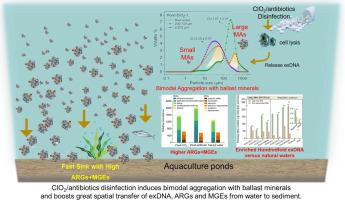当前位置:
X-MOL 学术
›
Water Res.
›
论文详情
Our official English website, www.x-mol.net, welcomes your
feedback! (Note: you will need to create a separate account there.)
Aquaculture oxidant (ClO2) or antibiotic disinfection induces unique bimodal aggregation and boosts exDNA sedimentation: A disinfection-driven great spatial shift of antibiotic resistance risk
Water Research ( IF 11.4 ) Pub Date : 2024-11-19 , DOI: 10.1016/j.watres.2024.122820 Lizhi He, Ming Zhang, Jiahao Li, Qingdong Duan, Daoyong Zhang, Xiangliang Pan
Water Research ( IF 11.4 ) Pub Date : 2024-11-19 , DOI: 10.1016/j.watres.2024.122820 Lizhi He, Ming Zhang, Jiahao Li, Qingdong Duan, Daoyong Zhang, Xiangliang Pan

|
ClO2 has been ever-increasingly used as an alternative disinfectant to alleviate antibiotic resistance risk in aquaculture. However, the feasibility of ClO2 disinfection in reducing antibiotic resistance has not been clarified yet. We comparatively explored the aggregation mechanisms and their effect on extracellular DNA (exDNA) partition and settlement in disinfected aquaculture waters and natural waters. In contrast to the unimodal aggregation in natural non-aquaculture waters, a unique bimodal size distribution pattern of micron-sized aggregates was found in aquaculture waters regardless of the disinfectants (macro-aggregates – 200-700 μm in diameter and micro-aggregates – 2-200 μm in diameter). The bimodal aggregates had 2-4 orders of magnitude higher content of Ferron cations and enriched hundred-fold exDNA in aquaculture waters than in natural waters. ExDNA was adsorbed on the surface of aggregates and conglutinated mainly by carbohydrates and coagulative cations. Macro-aggregates had lower fractal dimension but greater sedimentation velocities compared with micro-aggregates. Polylithionite was the key ballast mineral facilitating fast sedimentation of aggregates in aquaculture waters. Loading more antibiotic resistance genes and mobile gene elements, the aquaculture aggregates sank more rapidly from water to sediments than the natural-water aggregates. It indicates that disinfection with ClO2 or antibiotics facilitated the spatial transfer of antibiotic resistance risk with high horizontal transfer potential from water column to sediment through forming bimodal aggregates. These findings imply that the adoption of antibiotic alternatives such as the oxidant of ClO2 is far from sufficient to alleviate antibiotic resistance in aquaculture.
中文翻译:

水产养殖氧化剂 (ClO2) 或抗生素消毒诱导独特的双峰聚集并促进 exDNA 沉降:消毒驱动的抗生素耐药性风险的巨大空间转移
ClO2 越来越多地被用作替代消毒剂,以减轻水产养殖中的抗生素耐药性风险。然而,ClO2 消毒在降低抗生素耐药性方面的可行性尚未阐明。我们比较探讨了在消毒养殖水域和自然水域中聚集机制及其对细胞外 DNA (exDNA) 分配和定居的影响。与天然非水产养殖水域中的单峰聚集体相反,无论使用何种消毒剂(大聚集体 – 直径 200-700 μm,微聚集体 – 直径 2-200 μm),在水产养殖水中都发现了微米级聚集体的独特双峰尺寸分布模式。与自然水域相比,双峰聚集体在水产养殖水域中的铁阳离子含量高 2-4 个数量级,并且富含 100 倍的 exDNA。ExDNA 吸附在聚集体表面,主要被碳水化合物和凝固阳离子凝聚。与微团聚体相比,宏观团聚体具有较低的分形维数,但具有较高的沉降速度。聚石是关键的压载矿物,有助于聚集体在水产养殖水域中快速沉淀。加载更多的抗生素抗性基因和移动基因元件,水产养殖团聚体从水中沉到沉积物的速度比天然水团聚体更快。它表明,用 ClO2 或抗生素消毒促进了抗生素耐药性风险的空间转移,通过形成双峰聚集体,具有从水柱到沉积物的高水平转移潜力。 这些发现意味着采用抗生素替代品(例如 ClO2 的氧化剂)远不足以缓解水产养殖中的抗生素耐药性。
更新日期:2024-11-19
中文翻译:

水产养殖氧化剂 (ClO2) 或抗生素消毒诱导独特的双峰聚集并促进 exDNA 沉降:消毒驱动的抗生素耐药性风险的巨大空间转移
ClO2 越来越多地被用作替代消毒剂,以减轻水产养殖中的抗生素耐药性风险。然而,ClO2 消毒在降低抗生素耐药性方面的可行性尚未阐明。我们比较探讨了在消毒养殖水域和自然水域中聚集机制及其对细胞外 DNA (exDNA) 分配和定居的影响。与天然非水产养殖水域中的单峰聚集体相反,无论使用何种消毒剂(大聚集体 – 直径 200-700 μm,微聚集体 – 直径 2-200 μm),在水产养殖水中都发现了微米级聚集体的独特双峰尺寸分布模式。与自然水域相比,双峰聚集体在水产养殖水域中的铁阳离子含量高 2-4 个数量级,并且富含 100 倍的 exDNA。ExDNA 吸附在聚集体表面,主要被碳水化合物和凝固阳离子凝聚。与微团聚体相比,宏观团聚体具有较低的分形维数,但具有较高的沉降速度。聚石是关键的压载矿物,有助于聚集体在水产养殖水域中快速沉淀。加载更多的抗生素抗性基因和移动基因元件,水产养殖团聚体从水中沉到沉积物的速度比天然水团聚体更快。它表明,用 ClO2 或抗生素消毒促进了抗生素耐药性风险的空间转移,通过形成双峰聚集体,具有从水柱到沉积物的高水平转移潜力。 这些发现意味着采用抗生素替代品(例如 ClO2 的氧化剂)远不足以缓解水产养殖中的抗生素耐药性。


















































 京公网安备 11010802027423号
京公网安备 11010802027423号